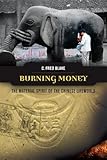Burning Money : The Material Spirit of the Chinese Lifeworld / C. Fred Blake.
Material type: TextPublisher: Honolulu : University of Hawaii Press, [2011]Copyright date: ©2011Description: 1 online resource (272 p.) : 16 illusContent type:
TextPublisher: Honolulu : University of Hawaii Press, [2011]Copyright date: ©2011Description: 1 online resource (272 p.) : 16 illusContent type: - 9780824835323
- 9780824860103
- 393/.90951 23
- BL1812.R57 B53 2012
- online - DeGruyter
- Issued also in print.
| Item type | Current library | Call number | URL | Status | Notes | Barcode | |
|---|---|---|---|---|---|---|---|
 eBook
eBook
|
Biblioteca "Angelicum" Pont. Univ. S.Tommaso d'Aquino Nuvola online | online - DeGruyter (Browse shelf(Opens below)) | Online access | Not for loan (Accesso limitato) | Accesso per gli utenti autorizzati / Access for authorized users | (dgr)9780824860103 |
Frontmatter -- Contents -- Acknowledgments -- Introduction -- Chapter 1. Chiasm -- Chapter 2. Endless Scroll -- Chapter 3. Origins -- Chapter 4. Liturgy -- Chapter 5. Ideology -- Chapter 6. Sacrifice -- Chapter 7. Ghost Bills -- Chapter 8. Burlesque -- Chapter 9. Value -- A Postscript on the Grain of Sand -- Notes -- Glossary -- References -- Index -- About the Author
restricted access online access with authorization star
http://purl.org/coar/access_right/c_16ec
For a thousand years across the length and breadth of China and beyond, people have burned paper replicas of valuable things-most often money-for the spirits of deceased family members, ancestors, and myriads of demons and divinities. Although frequently denigrated as wasteful and vulgar and at times prohibited by governing elites, today this venerable custom is as popular as ever. Burning Money explores the cultural logic of this common practice while addressing larger anthropological questions concerning the nature of value. The heart of the work integrates Chinese and Western thought and analytics to develop a theoretical framework that the author calls a "materialist aesthetics." This includes consideration of how the burning of paper money meshes with other customs in China and around the world.The work examines the custom in contemporary everyday life, its origins in folklore and history, as well as its role in common rituals, in the social formations of dynastic and modern times, and as a "sacrifice" in the act of consecrating the paper money before burning it. Here the author suggests a great divide between the modern means of cultural reproduction through ideology and reification, with its emphasis on nature and realism, and previous pre-capitalist means through ritual and mystification, with its emphasis on authenticity. The final chapters consider how the burning money custom has survived its encounter with the modern global system and internet technology.Innovative and original in its interpretation of a common ritual in Chinese popular religion, Burning Money will be welcomed by scholars and students of Chinese religion as well as comparative religion specialists and anthropologists interested in contemporary social theory.
Issued also in print.
Mode of access: Internet via World Wide Web.
In English.
Description based on online resource; title from PDF title page (publisher's Web site, viewed 02. Mrz 2022)


